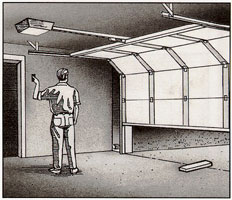|
Testing and Maintaining the Garage Door Opener
There are routine safety and maintenance steps that you should follow once a month. Review your owner's manual for the door opener. If you do not have an owners manual, look for the opener model number on the back of the power unit and request a manual from the manufacturer.
Routine Maintenance Can Prevent Tragedies
Take a few minutes to inspect and test your complete garage door system. Make monthly inspection and testing a part of your regular routine. Safety is everyone's business. Make garage door and garage door opener safety automatic in your home.
Monthly Maintenance Checklist
Garage Door Opener
- Reversal Test
- Force Setting Test
- Additional Safety Devices
Garage Door
- Visual Inspection - Springs, Rollers, Pulleys, Cables and Track
- Lubrication
- Door Balance
| Reversal TestMake sure your opener has a reversing feature. If a reversing feature is not present, it should be replaced. Garage door openers manufactured after January 1, 1993 are required by federal law to have advanced safety features which comply with the latest U.L. 325 standards: Contact your manufacturer or installer for additional information. Test the reversing feature every month. |
 |
 |
- First, test the balance of the door (see "Testing and Maintaining The Garage Door."). If the door is properly balanced, then proceed.
- With the door fully open, place a 1-1/2" thick piece of wood (a 2"x4" laid flat) on the flooring in the center of the door.
- Push the transmitter or wall button to close the door. The door must reverse when it strikes the wood. (Note that the bottom part of "one piece doors" must be rigid so that the door will not close without reversing.)
- If the door does not have reverse, have it repaired or replaced. Have a qualified individual adjust, repair or replace the opener or door.
Force Setting TestTest the force setting of your garage door opener by holding the bottom of the door as it closes. If the door does not reverse readily, the force may be excessive and need adjusting. See your owners manual for details on how to make the adjustment. Test the reversing feature after any adjustment.
Additional Safety DevicesMany garage door openers can be equipped with additional safety devices. Consider adding a photo eye or edge sensor as an extra measure of safety to prevent against entrapment. Keep in mind that adding more safety devices will not make an old opener meet current U.L. standards.
Make sure the additional safety devices, such as photoeyes or edge sensors, are properly installed and adjusted (see owner's manual).
Testing and Maintaining the Garage DoorPerform routine maintenance steps once a month. Review your owner's manual for the garage door. If you don't have a manual, look for the model number on the back of the door, or check the lock handle, hinges, or other hardware for the manufacturer's name and request a manual from the manufacturer.
Visual InspectionLook at the garage door springs, cables, rollers, pulleys, and other door hardware for signs of wear. If you suspect problems, have a qualified person make repairs.
Warning - Springs are under high tension.Garage door springs, cables, brackets, and other hardware attached to the springs, are under very high tension and, if handled improperly, can cause serious injury. Only a qualified professional or a mechanically experienced person carefully following the manufacturer's instructions should adjust them. The torsion springs (the springs above the door) should only be adjusted by a professional. Do not attempt to repair or adjust the torsion springs yourself.
A restraining cable or other device should be installed on the extension spring (the spring along the side of the door) to help contain the spring if it breaks.
Never remove, adjust or loosen the screws on the bottom brackets of the door. These brackets are connected to the spring by the lift cable and are under extreme tension.
LubricationRegularly lubricate the moving parts of the door. However, do not lubricate plastic parts such as plastic rollers and plastic idler bearings. Consult the door owner's manual for the manufacturer's recommendation.
Door BalancePeriodically test the balance of your door.
- Start with the door closed
- If you have a garage door opener, use the release mechanism so you can operate the door by hand when doing this test
- You should be able to lift the door smoothly and with little resistance. It should stay open around three or four feet above the floor. If it does not, it is out of adjustment. Have it adjusted by a qualified service person.
|
|